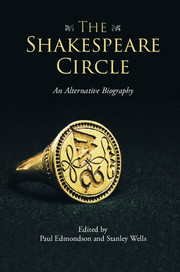Book contents
- Frontmatter
- Contents
- List of illustrations
- List of contributors
- Preface and acknowledgements
- General introduction
- Part I Family
- 1 His Mother Mary Shakespeare
- 2 His father John Shakespeare
- 3 His siblings
- 4 His sister's family: the Harts
- 5 His wife Anne Shakespeare and the Hathaways
- 6 His daughter Susanna Hall
- 7 His son-in-law John Hall
- 8 His son Hamnet Shakespeare
- 9 His daughter Judith and the Quineys
- 10 His granddaughter Lady Elizabeth Barnard
- 11 His ‘cousin’: Thomas Greene
- Part II Friends and Neighbours
- Part III Colleagues and Patrons
- Closing remarks
- Afterword
- Index
- References
6 - His daughter Susanna Hall
from Part I - Family
Published online by Cambridge University Press: 05 November 2015
- Frontmatter
- Contents
- List of illustrations
- List of contributors
- Preface and acknowledgements
- General introduction
- Part I Family
- 1 His Mother Mary Shakespeare
- 2 His father John Shakespeare
- 3 His siblings
- 4 His sister's family: the Harts
- 5 His wife Anne Shakespeare and the Hathaways
- 6 His daughter Susanna Hall
- 7 His son-in-law John Hall
- 8 His son Hamnet Shakespeare
- 9 His daughter Judith and the Quineys
- 10 His granddaughter Lady Elizabeth Barnard
- 11 His ‘cousin’: Thomas Greene
- Part II Friends and Neighbours
- Part III Colleagues and Patrons
- Closing remarks
- Afterword
- Index
- References
Summary
William Shakespeare's monument in Holy Trinity Church will have caused quite a stir in Stratford when installed, sometime between 1616 and 1623. Such ‘aedificated’ (partly resembling a house), wall-mounted memorials became increasingly fashionable during the seventeenth century; Shakespeare's was thus reasonably early, and has been described as one of the best (Curl 2002, p. 118). Its novelty points to its having been wholly designed in London or by Londoners, though its placement clearly required an influential Stratford voice. Whose idea it was, we cannot know. Its uniqueness lies in its claims for its subject.
Ivdicio Pylium, Genio Socratem, Arte Maronem,
Terra Tegit, Populus MÆRet, Olympus Habet
Stay Passenger, Why Goest Thov By So Fast?
Read If Thov Canst, Whom Enviovs Death Hath Plast
With In This Monvment Shakspeare: With Whome,
Qvick Natvre Dide: Whose Name, Doth Deck Ys Tombe,
Far More, Then Cost: Sieh All, Yt He Hath Writt,
Leaves Living Art, Bvt Page, To Serve His Witt.
The Latin lines tell us that Olympus now owns one whom earth buries and the people mourn, who was as wise as Nestor, as intelligent as Socrates, and whose art was level with Virgil's.
‘Stay passenger’; we are passers-by, in space but also, in context, in time. ‘Read if thou canst’: what if we can't? Jokes about notices announcing classes for illiterates spring to mind. Maybe by ‘read’ we should understand ‘understand’. Presumably someone will read the words to us. ‘Whom’ may seem at first to refer to ‘thou’, opening a disconcerting abyss at the line's end. We ourselves die for a moment. The poem's iambic pentameters run smoothly until we hit ‘Shakespeare’, a meaningfully disruptive inversion of stress, a trochee where an iamb is due. ‘Quick’ means ‘pregnant’; ‘dide’ irreverently proposes an erotic sense of ‘did’ as well as dying, itself a frequent metaphor for orgasm. ‘A pun was his fatal Cleopatra’, wrote Dr Johnson; here, it is somebody else's.
That somebody else, a competent versifier, rhymes efficiently and unobtrusively. The lurch after the second line may be deliberate, but it unfortunately deflects us from the verse's main purpose; if intended, it pursues a local effect distracting from the whole, the kind of ambitious mistake a young poet might well make. The stressing of ‘Shakspeare’, though, is accomplished.
- Type
- Chapter
- Information
- The Shakespeare CircleAn Alternative Biography, pp. 71 - 85Publisher: Cambridge University PressPrint publication year: 2015
References
- 1
- Cited by

